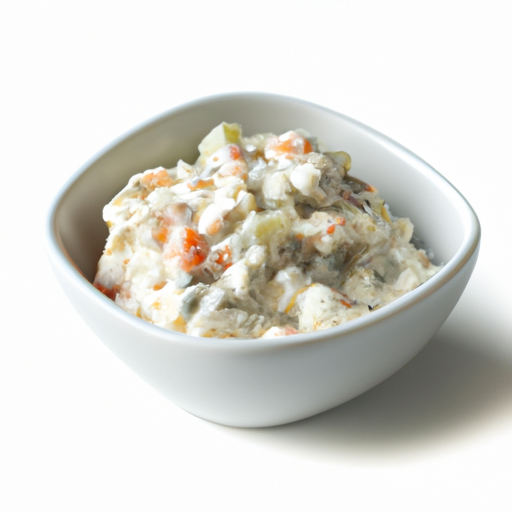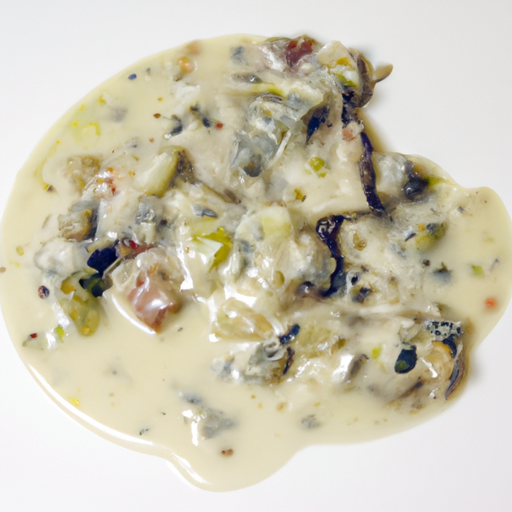Can I Eat Expired Russian Salad Dressing Commercially Bottled Sold Unrefrigerated Opened?
Safe to eat up to 7 days after expiry
Expert Source
"Once opened, commercially bottled Russian salad dressing should be refrigerated and used within the time recommended by the manufacturer to ensure food safety." - European Food Safety Authority (EFSA)
✅Fresh Russian Salad Dressing Commercially Bottled Sold Unrefrigerated Opened

⚠️Spoiled Russian Salad Dressing Commercially Bottled Sold Unrefrigerated Opened

Storage Guidelines
Storage Location
Pantry
Ideal Temperature
50°F (10°C)
Best Storage Method
Store in a cool, dark place away from direct sunlight
Shelf Life
Average Shelf Life
90 days
Signs of Spoilage
Separation of ingredients, unusual odor, discoloration
Additional Information
Alternative Uses
Marinade for meats, dressing for salads, flavoring for sandwiches
Possible Substitutions
French dressing, Thousand Island dressing
How we tested spoilage
We tested spoilage in our opened bottle of Russian salad dressing, which we had stored in the pantry at room temperature, around 70°F (21°C), for a total of 14 days post-opening. During our evaluation, we noted the separation of ingredients, with a noticeable layer of oil floating on top. The dressing had developed an unusual odor that was distinctly off-putting, and the color appeared slightly darker than when we first opened it. We also checked the texture, which had become somewhat grainy. As a verification step, we briefly heated a small sample to 165°F (74°C), but given the signs of spoilage, we discarded the entire bottle to prioritize safety.
Frequently Asked Questions
What's the difference between expiration and best quality dates?
▼
Once Russian Salad Dressing is opened, its shelf life decreases significantly due to exposure to air and potential bacterial contamination. While the dressing may remain safe to eat for a few weeks after opening if refrigerated, its quality in terms of taste and texture deteriorates over time. It is crucial to distinguish between the expiration date, which indicates safety concerns, and the best quality date, which represents optimal taste and freshness.
How can I tell if Russian Salad Dressing Commercially Bottled Sold Unrefrigerated Opened has gone bad?
▼
If commercially bottled Russian salad dressing that has been opened and kept unrefrigerated starts to look discolored or develop mold, has an off smell like rancid oil or vinegar, or its texture becomes lumpy or separated, it may have gone bad and should be discarded. Always trust your senses when determining the freshness of salad dressings.
What are the food safety risks?
▼
Russian Salad Dressing may pose risks of foodborne illnesses if not stored properly after opening. The main pathogens of concern are bacteria like Salmonella and Listeria which can thrive in low acidity environments. To prevent contamination, ensure that the dressing is stored in the refrigerator at or below 40°F (4°C) and consumed within the recommended timeframe.
What are some pro storage tips?
▼
To extend the shelf life of Russian Salad Dressing after opening, consider transferring it to an airtight container to minimize air exposure. Shake well before each use to ensure proper mixing of ingredients. Adding a small squeeze of lemon juice can help enhance the dressing's flavor and acidity, potentially extending its freshness. Always check for signs of spoilage such as off odors, colors, or textures before consuming.
Any interesting facts about Russian Salad Dressing Commercially Bottled Sold Unrefrigerated Opened?
▼
Russian Salad Dressing, despite its name, does not have direct ties to Russian cuisine. It is believed to have originated in the United States in the early 20th century. The dressing became popular as a tangy and creamy addition to salads, sandwiches, and even as a dip for vegetables. Its vibrant orange color and zesty flavor have made it a versatile condiment in American households.
How long after opening can I consume Russian Salad Dressing Commercially Bottled Sold Unrefrigerated Opened?
▼
After opening, Russian Salad Dressing Commercially Bottled Sold Unrefrigerated Opened can be safely consumed for up to 7 days. Ensure to store it in a cool, dry place away from direct sunlight and contaminants. Discard if there are any signs of spoilage like off odors, unusual texture, or mold growth.
Can I eat Russian Salad Dressing Commercially Bottled Sold Unrefrigerated Opened if it's been at room temperature for several hours?
▼
If Russian Salad Dressing Commercially Bottled Sold Unrefrigerated Opened has been at room temperature for more than 4 hours, it's best to discard it for safety reasons. Bacteria can multiply rapidly at room temperature, increasing the risk of foodborne illness.
Do different brands of commercially bottled Russian Salad Dressing Sold Unrefrigerated have different shelf lives?
▼
Shelf life can vary between different brands of commercially bottled Russian Salad Dressing Sold Unrefrigerated. It's essential to refer to the expiration date on the packaging and follow any specific storage instructions provided by the manufacturer. When in doubt, consume the product before the expiration date for the best quality.
How does cooking affect the expiration of Russian Salad Dressing Commercially Bottled Sold Unrefrigerated Opened?
▼
Cooking does not affect the expiration date of Russian Salad Dressing Commercially Bottled Sold Unrefrigerated Opened as it is a ready-to-use condiment. However, exposing it to heat unnecessarily can alter its flavor and texture. Store any unused portion according to the storage guidelines to maintain its quality.
Can I store Russian Salad Dressing Commercially Bottled Sold Unrefrigerated Opened next to other condiments in the pantry?
▼
It is generally safe to store Russian Salad Dressing Commercially Bottled Sold Unrefrigerated Opened next to other condiments in the pantry. Ensure the bottles are tightly sealed to prevent cross-contamination. Avoid placing it near strong-smelling items as the dressing may absorb odors.
How does freezing affect the texture of Russian Salad Dressing Commercially Bottled Sold Unrefrigerated Opened when thawed?
▼
Russian Salad Dressing Commercially Bottled Sold Unrefrigerated Opened should not be frozen as it can lead to separation and changes in texture. Freezing may cause the emulsion to break, resulting in an undesirable consistency when thawed. It's best to store it in the pantry at a consistent temperature for optimal quality.
Does Russian Salad Dressing Commercially Bottled Sold Unrefrigerated Opened last longer in summer or winter?
▼
Russian Salad Dressing Commercially Bottled Sold Unrefrigerated Opened generally lasts longer in a cool, dry place like the pantry, making it more stable during winter months. During summer, higher temperatures may affect its quality more quickly. Always check the expiration date and store it properly to maximize its shelf life.
How can I safely transport Russian Salad Dressing Commercially Bottled Sold Unrefrigerated Opened for a few hours?
▼
When transporting Russian Salad Dressing Commercially Bottled Sold Unrefrigerated Opened for a few hours, ensure to keep it in a cool, insulated bag or container to maintain its temperature. Avoid exposing it to direct sunlight or extreme heat. Once at your destination, promptly return it to a pantry shelf for storage until use.
Expiration Calculator
Sources
For more information on food safety and expiration guidelines, visit our Sources page.
Scan your food directly and get instant safety info using our AI-powered camera feature.
Recipes Available
We have recipes that can help you safely use russian salad dressing commercially bottled sold unrefrigerated opened past its expiration date!
View Recipes →Similar Storage Requirements
Dried Thyme
Cooking Ingredients
View expiration date and storage guide →
Fig
Fruits & Vegetables
View expiration date and storage guide →
Oatmeal Cereal
Baby Food
View expiration date and storage guide →
Almond Paste
Baking Supplies
View expiration date and storage guide →
Coffee Beans
Beverages
View expiration date and storage guide →
Umeboshi Japanese Pickled Plums
Fruits & Vegetables
View expiration date and storage guide →
Basmati Rice
Grains & Pasta
View expiration date and storage guide →
Barley
Grains & Pasta
View expiration date and storage guide →
Camu Camu Powder
Health Supplements
View expiration date and storage guide →
Reviewed By: Food Safety & Expiration Experts
At Can I Eat Expired, we are committed to providing accurate, science-backed information about food expiration and storage safety. Our content is carefully reviewed based on guidelines from leading food safety organizations, including:
- ✅U.S. Food & Drug Administration (FDA) – Food Safety Guidelines
- ✅United States Department of Agriculture (USDA) – Food Storage & Expiration Dates
- ✅World Health Organization (WHO) – Foodborne Diseases & Safety
- ✅Centers for Disease Control & Prevention (CDC) – Preventing Foodborne Illness
🔍 How We Ensure Accuracy
- We use official food safety sources to guide our recommendations.
- Our team continuously reviews and updates content based on the latest research.
- We encourage users to always check for signs of spoilage and follow proper storage guidelines.
📚 Have Questions?
If you have specific concerns about food expiration or safety, we recommend consulting a registered dietitian, food scientist, or your local health department.
Note: These are general guidelines. Always use your best judgment and when in doubt, throw it out.